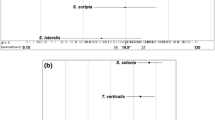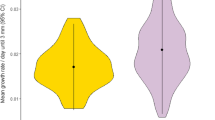Abstract
The aquatic and terrestrial realms differ in many physical properties that not only require specific physiological adaptations but also cause differences in dispersal options. We thus expect that life-history traits related to dispersal and colonization are under selection pressure because freshwater habitats are more isolated and thus more difficult to reach. We compared traits from European databases of three taxonomic groups along the passive–active dispersal gradient: plants (Plantes), snails (Mollusca: Gastropoda: Prosobranchia et Pulmonata) and hoverflies (Diptera: Syrphidae), all of which have both terrestrial and freshwater species (plants and snails) or early life stages (hoverflies). Aquatic taxa seem to be more successful long-distance dispersers than are terrestrial taxa. Our analysis also revealed lower numbers of seeds or eggs produced in the aquatic habitats. However, aquatic taxa often allocate resources to offspring guarding (vegetative propagules in plants, egg capsules in snails) and breeding-site selection (syrphids). Colonization of the aquatic realm is reinforced by increases in life span (plants), clonal spread (plants), shorter generation times (snails), selfing ability (marginal effect in pulmonate snails) or paedogenesis (two incidences in hoverflies, needs further studies). Probably, the variety of strategies reflects the different evolutionary backgrounds that elicit different combinations of trade-offs, but all traits also might increase invasibility of species.





Similar content being viewed by others
References
Abbott KC (2011) A dispersal-induced paradox: synchrony and stability in stochastic metapopulations. Ecol Lett 14:1158–1169
Achterkamp B, Ottenheim M, Beukeboom LW, Brakefield PM (2000) Paedogenesis in Eristalis arbustorum (Diptera: Syrphidae). Proc Sect Experim Appl Entomol, Netherl Entomol Soc 11:83–97
Almohamad R, Verheggen F, Francis F, Haubruge E (2007) How does the age of hoverfly females affect their reproduction? Commun Agric Appl Biol Sci 72:503–508
Almohamad R, Verheggen FJ, Haubruge E (2009) Searching and oviposition behavior of aphidophagous hoverflies (Diptera: Syrphidae): a review. Biotech Agron Soc Environ 13:467–481
Altermatt F, Schreiber S, Holyoak M (2011) Interactive effects of disturbance and dispersal directionality on species richness and composition in metacommunities. Ecology 92:859–870
Boedeltje G, Bakker JP, Bekker RM, Van Groenendael JM, Soesbergen M (2003) Plant dispersal in a lowland stream in relation to occurrence and three specific life-history traits of the species in the species pool. J Ecol 91:855–866
Bonn S, Poschlod P, Tackenberg O (2000) Diasporus—a database for diaspore dispersal—concept and applications in case studies for risk assessment. Z Ökol Natursch 9:85–97
Castella E, Speight MCD (1996) Knowledge representation using fuzzy coded variables: an example based on the use of Syrphidae (Insecta, Diptera) in the assessment of riverine wetlands. Ecol Model 85:13–25
Cook CDK (1996) The aquatic plant book. SPB Academic Publishing, Amsterdam
Correa SB, Winemiller KO, Lopez-Fernandez H, Galetti M (2007) Evolutionary perspectives on seed consumption and dispersal by fishes. Bioscience 57:748–756
Coulton HD, Pennymaker M (1934) The results of twenty years of self-fertilization in the snail Lymnaea columella Say. Am Nat 68:129–136
Ellenberg H (1992) Zeigerwerte der Gefäßpflanzen (ohne Rubus). In: Ellenberg H, Weber HE, Düll R, Wirth V, Werner W, Paulißen D (eds) Zeigerwerte von Pflanzen in Mitteleuropa. Scripta Geobotanica vol. 18. Goltze, Göttingen, pp 9–166
Falkner G, Obrdlik P, Castella E, Speight MCD (2001) Shelled Gastropoda of western Europe. Friedrich Held Gesellschaft, München
Fox JA, Dybdahl MF, Jokela CM, Lively J (1996) Genetic structure of coexisting sexual and clonal subpopulations in a freshwater snail (Potamopyrgus antipodarum). Evolution 50:1541–1548
Gardner SN, Mangel M (1999) Modeling investments in seeds, clonal offspring, and translocation in a clonal plant. Ecology 80:1202–1220
Heger TJ, Mitchell EAD, Todorov M, Golemansky V, Lara E, Leander BS, Pawlowski J (2010) Molecular phylogeny of euglyphid testate amoebae (Cercozoa: Euglyphida) suggests transitions between marine supralittoral and freshwater/terrestrial environments are infrequent. Mol Phylogenet Evol 55:113–122
Hemptinne J-L, Dixon AFG, Doucet J-L, Petersen J-E (1993) Optimal foraging by hoverflies (Diptera: Syrphidae) and ladybirds (Coleoptera: Coccinellidae): mechanisms. Eur J Entomol 90:451–455
Henry P-Y, Vimond L, Lenormand T, Jarne P (2006) Is delayed selfing adjusted to chemical cues of density in the freshwater snail Physa acuta? Oikos 112:448–455
Hintze C, Heydel F, Hoppe C, Cunze S, König A, Tackenberg O (2013) D3: the dispersal and diaspore database—baseline data and statistics on seed dispersal—perspect. Plant Ecol Evol Syst 15:180–192
Honnay O, Bossuyt B, Verheyen K, Butaye J, Jacquemyn H, Hermy M (2002) Ecological perspectives for the restoration of plant communities in European temperate forests. Biodivers Conserv 11:213–242
Horvath TG, Lamberti G (1997) Drifting macrophytes as a mechanism for zebra mussel (Dreissena polymorpha) invasion of lake-outlet streams. Am Midl Nat 138:29–36
Ibrahim IA, Gad AM (1975) The occurrence of paedogenesis in Eristalis larvae (Diptera Syrphidae). J Med Entomol 12:268–268
Kappes H, Haase P (2012) Slow, but steady: dispersal velocity and strategies of freshwater molluscs. Aquat Sci 74:1–14
Kappes H, Sundermann A, Haase P (2011) Distant land use affects terrestrial and aquatic habitats of high naturalness. Biodivers Conserv 20:2297–2309
Kearney M (2005) Hybridization, glaciation and geographical parthenogenesis. Trends Ecol Evol 20:495–502
Kerney MP, Cameron RAD, Jungbluth JH (1983) Die Landschnecken Nord- und Mitteleuropas. Paul Parey, Hamburg
Kinlan BP, Gaines SD (2003) Propagule dispersal in marine and terrestrial environments: a community perspective. Ecology 84:2007–2020
Kleyer M, Bekker RM, Knevel IC et al (2008) The LEDA traitbase: a database of life-history traits of the Northwest European flora. J Ecol 96:1266–1274
Klimeš L, Klimešová J, Hendriks R, van Groenendael J (1997) Clonal plant architecture: a comparative analysis of form and function. In: de Kroon H, van Groenendael J (eds) The ecology and evolution of clonal plants. Backhuys Publishers, Leiden, pp 1–29
Klimešová J, de Bello F (2009) CLO-PLA: the database of clonal and bud bank traits of Central European flora. J Veg Sci 20:511–516
Klotz S, Kühn I, Durka W (2002) BIOLFLOR – Eine Datenbank mit biologisch-ökologischen Merkmalen zur Flora von Deutschland. Landwirtschaftsverlag, Münster
Kobialka H, Schwer H, Kappes H (2009) Rote Liste der gefährdeten Schnecken und Muscheln (Mollusca: Gastropoda et Bivalvia) in Nordrhein-Westfalen. 3. Fassung 2009. Mitt Deutsch Malakozool Ges 82:3–30
Kurokawa H, Peltzer D, Wardle D (2010) Plant traits, leaf palatability and litter decomposability for co-occurring woody species differing in invasion status and nitrogen fixation ability. Funct Ecol 24:513–523
Latzel V, Klimesova J, Dolezal J, Pysek P, Tackenberg O, Prach K (2011) The association of dispersal and persistence traits of plants with different stages of succession in Central European man-made habitats. Folia Geobot 46:289–302
Maltz TK, Sulikowska-Drozd A (2008) Life cycles of clausilids in Poland—knowns and unknowns. Ann Zool 58:857–880
McCracken GF, Selander RK (1980) Self-fertilization and monogenic strains in natural populations of terrestrial slugs. Proc Nat Acad Sci USA 77:684–688
McLachlan JS, Hellmann JJ, Schwartz MW (2007) A framework for debate of assisted migration in an era of climate change. Conserv Biol 21:297–302
Moorkens EA, Killeen IJ (2009) Database of association with habitat and environmental variables for non-shelled slugs and bivalves of Britain and Ireland. Irish Wildlife Manuals, No. 41. National Parks and Wildlife Service, Department of the Environment, Heritage and Local Government, Dublin, Ireland
Nolte AW (2011) Dispersal in the course of an invasion. Mol Ecol 20:1803–1804
Öster M, Ask K, Römermann C, Tackenberg O, Eriksson O (2009) Plant colonization of ex-arable fields from adjacent species-rich grasslands: the importance of dispersal versus recruitment ability. Agric Ecosyst Environ 130:93–99
Peck LS (2011) Organisms and responses to environmental change. Mar Genomics 4:237–243
Pérez-Harguindeguy N, Díaz S, Vendramini F, Cornelissen JHC, Gurvich DE, Cabido M (2003) Leaf traits and herbivore selection in the field and in cafeteria experiments. Austral Ecol 28:642–650
Phillips BL, Brown GP, Shine R (2010) Life-history evolution in range-shifting populations. Ecology 91:1617–1627
Pianka ER (1970) On r- and K-selection. Am Nat 104:592–597
Pinceel J, Jordaens K, Houtte N, Bernon G, Backeljau T (2005) Population genetics and identity of an introduced terrestrial slug: Arion subfuscus s.l. in the north-east USA (Gastropoda, Pulmonata, Arionidae). Genetica 125:155–171
Pollux BJA (2011) The experimental study of seed dispersal by fish (ichthyochory). Freshw Biol 56:197–212
Poschlod P, Kleyer M, Jackel AK, Dannemann A, Tackenberg O (2003) BIOPOP—a database of plant traits and Internet application for nature conservation. Folia Geobot 38:263–271
Roll U, Dayan T, Simberloff D, Mienis HK (2009) Non-indigenous land and freshwater gastropods in Israel. Biol Invas 11:1963–1972
Ruhl JB (2010) Assisted colonization: facilitate migration first. Science 330:1317–1318
Santamaría L (2002) Why are most aquatic plants widely distributed? Dispersal, clonal growth and small-scale heterogeneity in a stressful environment. Acta Oecol 23:137–154
Schleicher A, Peppler-Lisbach C, Kleyer M (2011) Functional traits during succession: is plant community assembly trait-driven? Preslia 83:347–370
Selander RK, Kaufman DW (1973) Self-fertilization and genetic population structure in a colonizing land snail. Proc Nat Acad Sci USA 70:1186–1190
Sosnová M, van Diggelen R, Klimešová J (2010) Distribution of clonal growth forms in wetlands. Aquat Bot 92:33–39
Speight MCD, Monteil C, CastellaE, Sarthou J-P (2010) StN 2010. In: Speight MCD, Castella E, Sarthou J-P, Monteil C (ed) Syrph the Net on CD, Issue 7. The database of European Syrphidae. Syrph the Net Publications, Dublin
Statzner B, Hoppenhaus K, Arens M-F, Richoux P (1997) Reproductive traits, habitat use and templet theory: a synthesis of world-wide data on aquatic insects. Freshw Biol 38:109–135
Tackenberg O, Poschlod P, Bonn S (2003) Assessment of wind dispersal potential in plant species. Ecol Monogr 73:191–205
Travis SE, Proffitt CE, Ritland K (2004) Population structure and inbreeding vary with successional stage in created Spartina alterniflora marshes. Ecol Appl 14:1189–1202
Tsitrone A, Jarne P, David P (2003) Delayed selfing and resource reallocations in relation to mate availability in the freshwater snail Physa acuta. Am Nat 162:474–488
Umetsu CA, Antoniazi Evangelista HB, Thomaz SM (2012) The colonization, regeneration, and growth rates of macrophytes from fragments: a comparison between exotic and native submerged aquatic species. Aquat Ecol 46:443–449
Vermeij GJ (2000) Why are there so few evolutionary transitions between aquatic and terrestrial ecosystems? Biol J Linn Soc 70:541–554
Watson JR, Hays CG, Raimondi PT, Mitarai S, Dong C, McWilliams JC, Blanchette CA, Caselle JE, Siegel DA (2011) Currents connecting communities: nearshore community similarity and ocean circulation. Ecology 92:1193–1200
With KA (2004) Assessing the risk of invasive spread in fragmented landscapes. Risk Anal 24:803–815
Acknowledgments
This study was financed by the research funding program “LOEWE—Landes-Offensive zur Entwicklung Wissenschaftlich-oekonomischer Exzellenz” of Hesse’s Ministry of Higher Education, Research and the Arts. HK in part received financial support from the Netherlands Organisation for Scientific Research (NWO–ALW 821.01.002) while writing. OT received financial support from the DFG (TA 311/3). We also would like to thank Editor in Chief Piet Spaak (Eawag Dübendorf), Łukasz Głowacki (University Łódź), and an anonymous reviewer, for their highly valued comments on the manuscript.
Author information
Authors and Affiliations
Corresponding author
Additional information
Handling Editor: Piet Spaak.
Electronic supplementary material
Below is the link to the electronic supplementary material.
Rights and permissions
About this article
Cite this article
Kappes, H., Tackenberg, O. & Haase, P. Differences in dispersal- and colonization-related traits between taxa from the freshwater and the terrestrial realm. Aquat Ecol 48, 73–83 (2014). https://doi.org/10.1007/s10452-013-9467-7
Received:
Accepted:
Published:
Issue Date:
DOI: https://doi.org/10.1007/s10452-013-9467-7




